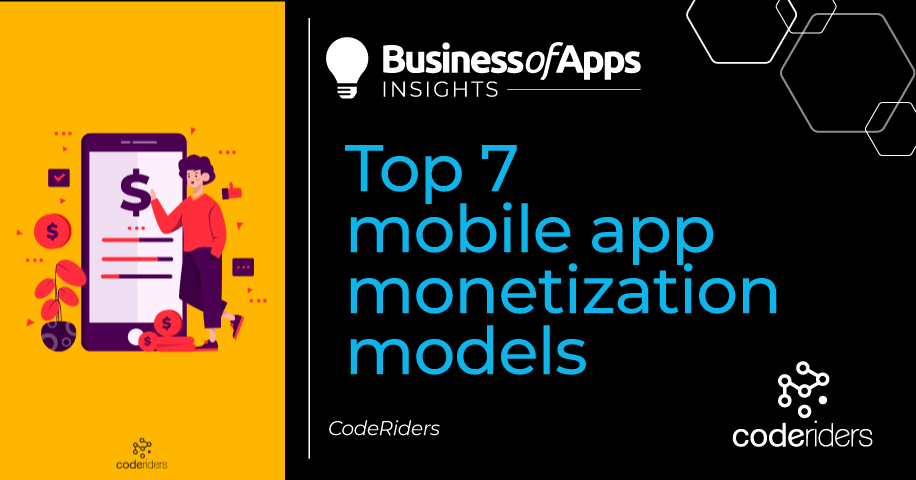According to Zippia’s latest statistics, the average smartphone owner unlocks their phone at least 150 times a day, while the average American will check their phone once every 10 to 12 minutes.
The mobile app industry evolves in the blink of an eye. 88% of mobile time is spent on apps, and over the last few years, the number of mobile app downloads has soared, reaching 255 billion annual downloads, according to Statista.
Building a mobile app can be easy, fast, and even affordable with qualified mobile app developers. However, we also want to make profits from it, don’t we? So, in a market of billions of free applications, how do you convince smartphone users that your app is the best solution and make a profit from it?
This is where mobile app monetization models and strategies come to the rescue.
What is mobile monetization and how does it work?
Monetizing apps refers to generating revenue from mobile applications, or, in other words, making money from your mobile apps. App developers and owners use a variety of monetization strategies and models to generate revenue from their apps while providing them to users for free or at a low cost.
Monetization is essential for covering development and operational expenses, generating profits, and ensuring the sustainability of the app business. There are various methods of mobile app monetization, each with its benefits and considerations.
In general, it is impossible to stay in the mobile app development market without a good and relatable mobile app monetization strategy.
Top mobile monetization models and strategies
In-app advertising
If the app owner uses the in-app advertising monetization model, this means that various advertisements are displayed within the application. The app owners or developers earn revenue based on the users’ interactions with the application which includes clicks and impressions.
In-app advertising is especially common in free mobile applications. The most widespread ad types include banner ads, interstitial ads, video ads, and native ads. Users usually have to watch some of these ads for at least 10 seconds before then being given the option to skip the ads.
Fire Up Your Growth!
Moburst propelled leading brands like Google, Reddit, and Uber to the next level. Let’s ignite your Success journey today!
Claim Your FREE Growth Fuel!- Banner ads: Banner ads have a horizontal layout on web pages and mobile apps and are typically in the form of a rectangular graphic or image spanning across the top, bottom, or sides of a webpage or app.
- Interstitial ads: Interstitial ads appear between two content pages or screens within a mobile app or a website. Unlike banner ads displayed within the content, interstitial ads take up the whole screen to grab the users’ attention.
- Video ads: Video ads use videos, and animations to convey a marketing message or promote a product through the power of visuals, motion, sound, and storytelling.
- Native ads: Native ads are designed like the surrounding content style, format, and context. The goal of native ads is to provide more natural advertisement causing less disruption to the users.
Pros and cons of in-app advertising
In-app advertising is an effective way to connect and engage with the target audience of the promoted service, brand, or product. Successfully integrated in-app ads even enhance users’ experience within the application, helping both the mobile app and the advertised content itself. It is also relatively easy to measure their performance and conversion rates, not to mention their monetization helping the app owners stream, support, and maintain their application.
With all these amazing advantages, in-app advertising also has several disadvantages such as destruction and intrusiveness, ad fatigue to the point when users just start ignoring the ads, space limitations, and privacy concerns. In-app advertising is a very widely used app monetization and digital marketing technique, which makes it increasingly challenging to grab users’ attention. Furthermore, because of incorrect and untargeted in-app advertising campaigns, some users use ad-blocking software to avoid in-app ads.
In-app advertising model in Flutter cross-platform mobile applications
One of the most widely used hybrid mobile app development frameworks, Flutter developed by Google provides a suite of integrations with monetization features to grow mobile app owners’ businesses who choose Flutter technology. Flutter app owners can easily integrate Google Mobile Ads SDK with both AdMob and Ad Manager. This is the first step towards supporting a variety of ad formats, including banners, interstitials, rewarded videos, and native ads to earn revenue.
Freemium model
The Freemium app monetization model is a strategy with which app owners provide free versions of their mobile applications with the possibility to upgrade the application for more advanced functions and features. This mobile app monetization strategy combines the words “free” and “premium” highlighting the two usage versions of the application.
The freemium monetization model works best if your mobile app provides high-quality in-demand features in the market for free of charge and then carries on with more advanced features that are mostly unique and of high value. The chances of your users buying your app’s pro or guru versions duplicate when you provide a high-quality service for free of charge and the users already feel comfortable using your application.
Pros and cons of the freemium model
Offering your highly developed app free of charge will attract user acquisition, expose the product to a larger user base, and convert free users into paying customers. Users will also have a chance to test the product before making any financial commitment. This method works best when your product has successfully executed a single or multiple branding campaign.
The risks of adapting the Freemium mobile app monetization model include poor balance between free and paid functions of the application, fewer paid customers highlighting insufficient reviews for maintaining the product (aside from getting profits) as well and misunderstanding of providing high-quality free functions for conversion.
In-app purchases (IAPs)
If a mobile application uses in-app purchases or an IAP monetization model, this means the app owner is ready to sell virtual products within their application. Virtual items may include digital content, additional features, or subscriptions directly within the app. Some examples of in-app purchases include:
- Virtual goods, are especially common in games, when users buy virtual items like power-ups, characters, levels, and virtual currencies such as coins, gems, and tokens.
- Some apps offer free features with the possibility of unlocking more advanced features and functionalities through purchase. For example, a photo editing app may provide additional filters like changing eye color, skin tone, and hairstyles by unlocking these features in the app.
- Content access is a widely used IAP method, especially by reputable magazines or content-providing platforms. This tactic offers its users monthly or subscription-based access to more advanced content such as tests, news, tutorials, lectures, etc.
- IAPs also fall into two main categories, consumables and non-consumables. Consumables are items that can be used up and purchased again while non-consumables are items that users buy or unlock once and use them without any deadlines.
- Subscription models: Under the IAP monetization model, the subscription-based model requires weekly, monthly, annually, or for any period purchased functions or items providing ongoing value to the user.
Pay-to-download (aka paid apps)
Paid-to-download or paid apps is a mobile app monetization model where users are required to pay an upfront fee to download and install a specific app from the app store. In this case, the users must pay a one-time fee to access the app’s features and functionalities. Paid apps require no further in-app purchases and subscriptions.
Most of the paid apps provide an ad-free experience or limited ads within the application, as users have already purchased the app during the installation process. Some paid apps may even add more features or content as part of the app’s free updates.
Sponsorships, partnerships and affiliate marketing programs
As the name states itself, sponsorship and partnership mobile app monetization strategy includes cooperating with various brands and companies to promote their products and services within the application. For the best practices, mobile app developers choose partners whose products and services align with their app’s target audience and values for mutual benefits.
The branded content should be smoothly integrated within the app’s interface and provide value to the app users such as offering discounts, and exclusive offers that align with the target audience’s interests. The apps earn money from such sponsorship deals in various ways such as one-time payments, revenue sharing based on the engagement, or both.
Some examples include fitness apps that can collaborate with various athletic brands to offer discounts to the app’s users, or travel apps that can partner with airlines, hotels, or travel agencies to offer special deals and packages for travel services.
On the other hand, with the help of an affiliate marketing mobile app monetization strategy, the app owners promote other companies’ products and services (affiliates) within their application in exchange for commissions on conversions generated through the app’s referral links.
Data monetization
Data monetization involves collecting and leveraging user data to generate revenue. This model has the purpose of analyzing user behavior, preferences, and trends to provide valuable insights to businesses, advertisers, or marketers. App developers may anonymize and aggregate user data to offer targeted advertising, personalized recommendations, or market research.
Licensing and white labeling
Licensing and white labeling involve creating an app or software solution and then licensing the technology or branding to other businesses or developers. These strategies can generate revenue by enabling others to use your app’s features under their brand.
Illustrating monetization strategies with a case study
Consider a case study from CodeRiders involving the development of property management software and a mobile app to better understand how various monetization strategies can be applied in real-world scenarios.
Through sub-contracting and white labeling cooperation, we helped Sinov8 one of the leading property management software providers in South Africa to build a cutting-edge PropTech solution. This is an ongoing project but so far we have successfully built the following features:
- Ability to download scheduled inspections and schedule new inspections directly on the app
- Ability to see an interactive list of inspections grouped by date
- Ability to review inspection details
- Ability to follow an inspection creation wizard that allows you to select or create a property, select or create the contacts, and then compile a starting point for the inspection
- Ability to capture the various conditions of each area and item and add any number of photos to each item
- Stunning capturing screen that is super feature-rich with beautiful animations
- Great built-in camera with features such as tap to focus and flash, which allows you to take multiple photos in quick succession to make the photo-taking process as quick and seamless as possible
Sinov8 also needs to adopt a monetization strategy for their mobile app to earn revenue from their investment.
Given the app’s functionality, several monetization models could be considered. Let’s explore several possibilities to illustrate how diverse strategies can be tailored to the app’s niche.”
- In-app advertising: This is a perfect approach to incorporating relevant ads that cater to property managers and real estate professionals. Apps can use banner ads, native ads, and video ads to provide quality assistance to its users and point them in the right direction with further assistance.
- Freemium model: With the high demand for Proptech mobile apps, this app can use the freemium model to provide several high-quality property management tools for free then use in-app purchases or subscriptions for more advanced features.
As you see, the monetization strategy of this mobile application has included more than one model. It’s critical to explore the most effective mobile app monetization tactics however, it’s also important to use the flexibility and adaptability of these different monetization strategies based on the nature of the app and its user base.
Contact team CodeRiders to learn more about mobile app development and its best practices.












